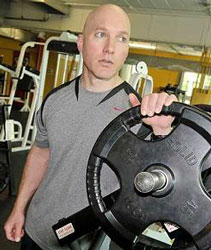Fitness Expert Interview With Clint Phillips
Clint Phillips -- personal trainer extraordinaire

I recently interviewed Clint Phillips, Chicago's top personal trainer. In the Chicago area when they say "fitness" they mean Clint Phillips.
That's why he was named one of the "Best Personal Trainers in America" by Men's Journal magazine 2 years in a row.
His stats:
Featured in numerous magazines and newspapers, including Army Times, Maximum Fitness Magazine, the Chicago Tribune and the Chicago Sun Times.
Invited lecturer on fitness at many universities including Northwestern University, De Paul University, Columbia College, and the University of Illinois at Chicago.
Honored as one of the "Best Personal Trainers in America" by the National Fitness Hall of Fame and Museum.
The Interview
Dr. Dan:
Clint, I know you were a sergeant in the U.S. Army, and a team you trained there set a post record for the 10 K. Is that where you got your start in the personal training field?
Clint Phillips:
I did a lot of physical training in the Army, and later in the Air Force, but that was mostly training large groups of people. I didn't start training individuals until I was at the University of Illinois at Chicago, after I left the military.
Dr. Dan:
You graduated from the University of Illinois at Chicago with a bachelor’s degree in Biological Sciences. You’re also certified by the American College of Sports Medicine. How does this degree of training translate into benefits for your clients?
Clint Phillips:
Surprisingly, it doesn't help much. The universities and certifying organizations are very far behind. What has helped me the most is learning by experience, and also from studying what other successful trainers do.
Dr. Dan:
You’re a sought after trainer, with clients from Northwestern University, University of Illinois at Chicago, Cook County Hospital and numerous other organizations. What is it that you offer in your training methods that causes these prestigious organizations to choose you?
Clint Phillips:
I offer an unusual approach. It's easy to find a personal trainer with a clipboard full of canned workouts, but I believe I bring a degree of creativity, originality, and variety that isn't seen very often.
Dr. Dan:
With your military background it isn’t surprising that you’ve worked with martial artists and professional arm wrestlers. But you also train ballet dancers. Two questions regarding this: First, are there basic training principles that apply to both the 100 pound ballerina and the 250 pound arm wrestler?
Clint Phillips:
First, arm wrestlers are not all 250 pounds! We have weight divisions. Arm wrestlers are training for something very specific: hand and wrist strength.
With the ballet dancers, they often come to me because they have problems, usually with their hips. Ballet is terrible on the hips. Hips aren't meant to turn out that far to the side.
This brings up a bigger issue. Most people (and many trainers) think flexibility is an unqualified positive: more is always better. I disagree.
Too much flexibility leads to instability in the corresponding joint, leaving it prone to injury. The only way to compensate for this hyperflexibility is to make sure the muscles that stabilize the joint are very strong.
Dr. Dan:
And second, how important is activity specific training -- in other words are there aspects of training that are just for dancers and others that are just for martial artists?
Clint Phillips:
Yes, I train martial artists very differently than ballet dancers, marathon runners, or powerlifters. Having said that, the great majority of my clients simply want to lose fat.
Dr. Dan:
Let’s take the arm wrestlers as an example. Do you train them to simply increase their pure brute force, or is there more involved in the sport than that?
Clint Phillips:
There is a lot of technique and strategy in arm wrestling. Most matches are over in a second or two, and two guys can arm wrestle 10 times and each might win half of the time.
It has a lot to do with being quick, and guessing which strategy your opponent is going to try. The most common technique is the top roll, next is the hook. There are many tricks and variations.
But one thing they all have in common is the need for strong hands and wrists. I've seen good arm wrestlers that weighed 30 pounds less than I do, who could take my arm down in a flash. They simply had better technique, and stronger wrists.
I could probably out bench press the same person by 100 pounds, but that doesn't help at all in an arm wrestling match.
Dr. Dan:
Dancers are fascinating. They are part athlete and part artist. They have a job that is physically demanding but yet must appear effortless. And they risk having their career cut short by injury. What training techniques should a dancer use to gain strength and flexibility while helping to minimize injuries?
Clint Phillips:
I don't train them at all in how to dance. That's up to their dance instructor. Their dance instructors have usually done too much flexibility work already.
I usually see them when they have problems, and I'm usually trying to get their hip abductors and adductors strong enough to make up for being too flexible.
Dr. Dan:
I know you’ve done a lot of work training people with physical disabilities and illnesses, like cerebral palsy, lupus and diabetes. Often people who are ill feel that they shouldn’t exercise, that they should just rest and not exert themselves. What’s been your experience in this area?
Clint Phillips:
Exercise almost always makes them feel better. It lubricates the joints, and releases endorphins.
I train a woman with severe arthritis. She begins her session by doing small arm circles, and she can barely get her hands elevated at all. By the end of the session, she can actually raise her hands above her head. It is amazing to see.
Dr. Dan:
The majority of adults in the U.S. are overweight. Many of them are looking for a quick and easy solution, and some have just given up altogether. Do you have any advice for someone who wakes up one day and finds themselves overweight and unhappy with the shape they’re in? Where should they start?
Clint Phillips:
They need to do three things: aerobic activity, strengthening, and eating right. There is too much more about each of the three to say here. I suggest getting a good personal trainer and a few fitness books.
Dr. Dan:
You’ve worked with morbidly obese teenagers. Are there any characteristics that you’ve been able to identify that lead to morbid obesity? How difficult is the problem and what results have you been able to achieve?
Clint Phillips:
It's tough. Some of those kids are over 500 pounds. I try to make exercise fun, so they won't end up hating it. But no matter how hard they work out, they can ruin it all with a Big Mac and a milkshake.
Part of the problem is genetic, and part of it is what the parents are feeding them. When I work with the morbidly obese teenagers, I see the parents when they come to pick the kids up. Most of the parents are huge too.
Dr. Dan:
Thank you Clint for sharing your valuable time and expertise with us. Where should we contact you for more information about your services?
Clint Phillips:
Contact me through http://www.chicago-personal-trainer.us or call me at (312) 371-6107.
Or write to us at:
1 W. Superior # 4717
Chicago, IL 60610
Popular articles:
With weight loss, knowledge is power...
If you know these few truths on this page -- and if you apply them consistently in your life...
If you can't stay on it forever and be fit and healthy and strong -- then it's an extreme diet.
Here's the easy way to ruin any slightest chance you have of losing weight...
Can you eat in restaurants and still respect yourself in the morning?
Calorie density is the difference between vegetable soup and a bagel.
Hidden calories that ruin your waistline...
Will it really help to drink water to lose weight?


